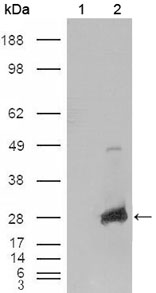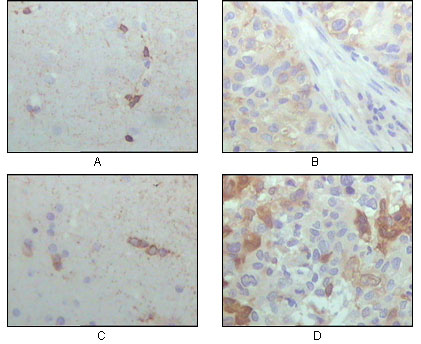Crystallin-αB Monoclonal Antibody
- 货号:YM0169
- 应用:WB;IHC;IF;ELISA
- 种属:Human
- 简介:
- >>Protein processing in endoplasmic reticulum;>>Longevity regulating pathway - multiple species
- 蛋白名称:
- Alpha-crystallin B chain
- 免疫原:
- Purified recombinant fragment of Crystallin-αB (aa1-175) expressed in E. Coli.
- 特异性:
- Crystallin-αB Monoclonal Antibody detects endogenous levels of Crystallin-αB protein.
- 组成:
- Liquid in PBS containing 50% glycerol, 0.5% BSA and 0.02% sodium azide.
- 稀释:
- WB 1:500 - 1:2000. IHC 1:200 - 1:1000. ELISA: 1:10000.. IF 1:50-200
- 纯化工艺:
- Affinity purification
- 储存:
- -15°C to -25°C/1 year(Do not lower than -25°C)
- 其他名称:
- CRYAB;CRYA2;Alpha-crystallin B chain;Alpha(B)-crystallin;Heat shock protein beta-5;HspB5;Renal carcinoma antigen NY-REN-27;Rosenthal fiber component
- 背景:
- Mammalian lens crystallins are divided into alpha, beta, and gamma families. Alpha crystallins are composed of two gene products: alpha-A and alpha-B, for acidic and basic, respectively. Alpha crystallins can be induced by heat shock and are members of the small heat shock protein (HSP20) family. They act as molecular chaperones although they do not renature proteins and release them in the fashion of a true chaperone; instead they hold them in large soluble aggregates. Post-translational modifications decrease the ability to chaperone. These heterogeneous aggregates consist of 30-40 subunits; the alpha-A and alpha-B subunits have a 3:1 ratio, respectively. Two additional functions of alpha crystallins are an autokinase activity and participation in the intracellular architecture. The encoded protein has been identified as a moonlighting protein based on its ability to perform mechanistically distin
- 功能:
- disease:Crystallins do not turn over as the lens ages, providing ample opportunity for post-translational modifications or oxidations. These modifications may change crystallin solubility properties and favor senile cataract.,disease:Defects in CRYAB are the cause of alpha-B crystallinopathy [MIM:608810]. Alpha-B crystallinopathy is a an autosomal dominant form of desmin-related myopathy (DRM) that results in weakness of the proximal and distal limb muscle (including neck, velopharynx, and trunk muscles), signs of cardiomyopathy and cataract. Patients with progressive myopathy characterized by myofibrillar degeneration that commences at the Z-disk, have been described. Mutations truncate the essential C-terminal domain of the protein required for the chaperone function.,disease:Seen as Rosenthal fiber protein in the brain tissue of patients with Alexander disease.,function:May contribute
- 细胞定位:
- Cytoplasm . Nucleus . Secreted . Lysosome . Translocates to the nucleus during heat shock and resides in sub-nuclear structures known as SC35 speckles or nuclear splicing speckles (PubMed:19464326). Localizes at the Z-bands and the intercalated disk in cardiomyocytes (PubMed:28493373). Can be secreted; the secretion is dependent on protein unfolding and facilitated by the cargo receptor TMED10; it results in protein translocation from the cytoplasm into the ERGIC (endoplasmic reticulum-Golgi intermediate compartment) followed by vesicle entry and secretion (PubMed:32272059). .
- 组织表达:
- Lens as well as other tissues (PubMed:838078, PubMed:2387586). Expressed in myocardial tissue (PubMed:28493373).

- Western Blot analysis using Crystallin-αB Monoclonal Antibody against HEK293T cells transfected with the pCMV6-ENTRY control (1) and pCMV6-ENTRY CRYAB cDNA (2).

- Immunohistochemistry analysis of paraffin-embedded human brain hippocampus (A), lung cancer (B), brain tumor (C), breast cance (D), showing cytoplasmic localization with DAB staining using Crystallin-αB Monoclonal Antibody.





